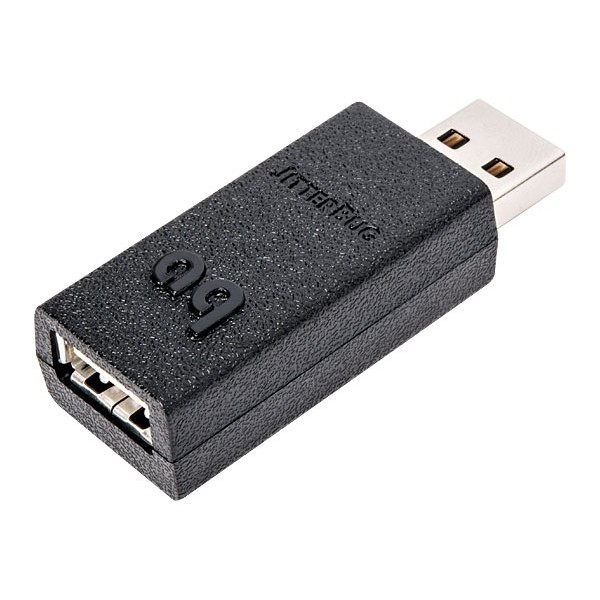





USB data & Power Noise Filter
USB data & Power Noise Filter
Dual Discrete Noise-Dissipation Circuits
The Problem: All computing devices—laptops, smartphones, Network Attached Storage devices (NAS drives), media servers, etc.—inherently generate a significant amount of noise and parasitic resonances. Additionally, computers contribute a considerable amount of RFI and EMI pollution onto the signal paths—all of which can easily find its way onto your USB cables and into your audio system. This noise and interference has many negative effects. Noise-compromised digital circuitry increases jitter and packet errors, resulting in distortion that causes a comparatively flat and irritating sound. Noise-compromised analog circuitry also damages the sound’s depth,
warmth and resolution.
The Solution: JitterBug’s dual-circuitry measurably reduces unwanted noise currents and parasitic resonances. It also reduces jitter and packet errors (in some cases, packet errors are completely eliminated).
The Result: Clearer and more compelling sound, music, dialog, etc. A better audio experience.
Q: Where can I use JitterBug?
A: JitterBug is primarily designed to work in series with a USB enabled DAC (and USB cable). Plugging one JitterBug in series with your USB DAC will help to improve the overall sound of your computer-audio system.
Q: Can I plug one JitterBug into another, having multiples in series?
A: No. Plugging two filters in series may have an adverse effect on the overall sound of a computer-audio system. Your system will likely work, but the sound may take a step backwards.
Q: Is JitterBug USB 3.0 compliant?
A: No. JitterBug is intentionally noncompliant with the 3.0 standard. Higher speeds result in higher frequencies and more noise. When used with USB 3.0 devices, JitterBug purposely decelerates the device to USB 2.0 specifications.
JitterBug’s dual-function line-conditioning circuitry works on both the data (communication) and vbus (power) lines of USB ports: The latter reduces noise and prevents EMI and RFI from contaminating the associated digital-to-analog converter (DAC) and/or cable. The former minimizes parasitic resonances created by the computer and USB bus, and is optimized to remove noise above the USB 2.0 frequency specification, making it ideal for audio playback.
When transferring large amounts of data, we suggest that you remove JitterBug from your device. Simply reinstall JitterBug prior to your next listening session. (See below: “Will JitterBug improve the sound of my computer audio even when I’m not using a USB DAC?”)
Q: Does JitterBug require a device driver installation?
A: Nope. JitterBug is a passive device. There are no active circuits or logic systems.
Q: How many Jitterbugs can I use on my computer?
A: In our observations, we have found that positive improvements are obtained with up to two parallel JitterBugs per USB bus. For example, a typical laptop will have two to three USB ports, but only one bus. So, using two JitterBugs and leaving the third port open will yield positive results, but installing a third JitterBug, in our opinion, takes a step backwards. When going beyond more than two JitterBugs per bus, the sound becomes dark and congested.
However, some computers may have more than one bus. Custom gaming laptops and PC towers are two examples of computers that may have more than one USB bus. In these cases, using two JitterBugs on each bus will yield extraordinary results. That said, if you don’t know how many buses are on your computer, err on the side of caution and assume there is only one bus.
Q: Will JitterBug improve the sound of my computer audio even when I’m not using a USB DAC?
A: Yes. For instance, if your computer is connected to your A/V system via Toslink or HDMI, and your music is stored on an external USB 2.0 or 3.0 hard drive, adding a JitterBug in between the external hard drive and computer will yield an overall improvement in sound.
While we recommend using JitterBug with USB hard drives, one may want to temporarily remove JitterBug when attempting to move large files over the 3.0 specification—that is, when both the USB bus and USB hard drive are both 3.0 compliant—in order to take advantage of 3.0’s speed. Once file transfer is complete, safely eject the hard drive, reinsert the JitterBug, and reconnect the hard drive.
Q: Can I use JitterBug with mobile devices?
A: Absolutely. Today’s mobile devices, such as Android and iOS phones and tablets, often function as one’s primary music source. Applications such as Bandcamp, iTunes, Google Play, NPR Music, Spotify, and Tidal offer nearly limitless access to music. Additionally, virtually all modern automobiles, A/V receivers, and many multi-input DACs now offer a front-panel Android/iOS USB connection port. As mobile phones generate a significant amount of noise and RF interference, adding a JitterBug in between your mobile device and your component’s USB input will yield meaningful improvements to the sound quality.
Known JitterBug Incompatibilities
It has come to our attention that JitterBug is incompatible with certain legacy USB microcontrollers (the microcontroller is the device inside of your USB DAC that sends and receives data packets [and sometimes power] from the computer to your DAC). Primarily, the issue seems to be that some legacy USB microcontrollers fall outside of the electrical specification set forth by the USB Organization.
How do I know if my DAC is incompatible?
Simple. One of two things will occur:
How did AudioQuest arrive at this conclusion?
AudioQuest has at its disposal a Tektronix USB analyzer. With this analyzer, we can test any and all devices (such as cables, DACs, filters, and hubs) and determine whether a component meets its specification. We go to painstaking lengths to ensure all of our USB-related devices and accessories meet the USB Organization’s specifications. This analyzer also allows us to look at other components, often leading to greater insight and collaboration between AudioQuest and our colleagues within the computer-audio industry.
